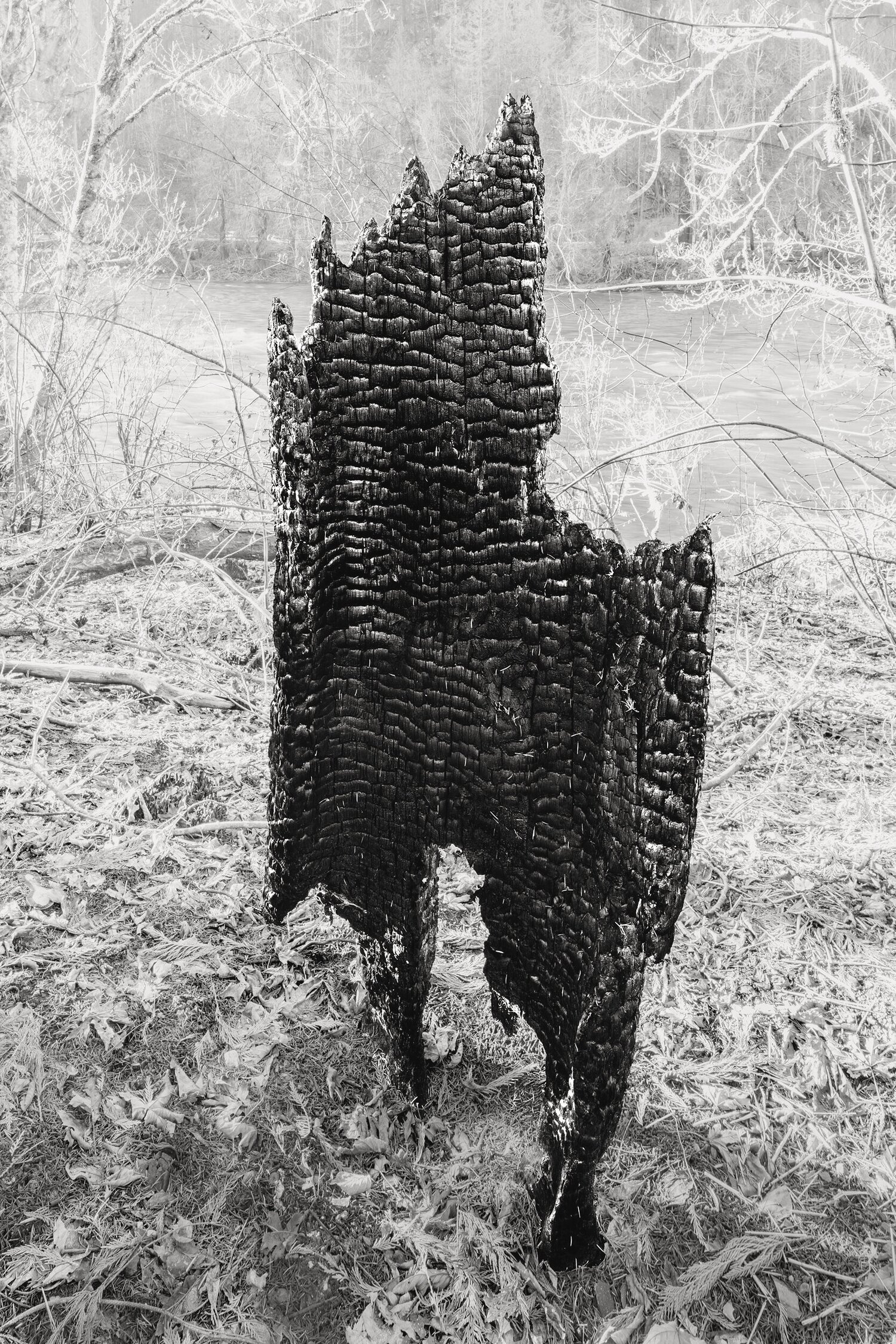
Art and Science: Portraits of Interconnectedness interview with collaborators David Paul Bayles and Fred Swanson
Olivia Ann Carye Hallstein
David Paul Bayles, photographer, and Fred Swanson, forest ecologist, are artists and science collaborators whose ongoing project portraying the ecological ramifications of human influence on Oregon trees creates both scientifically useful and hauntingly crafted portraits. In this work, art tells the story of the ongoing climate-related influences of the old-growth forest, and science provides factual information for making sound decisions. The most recent part of their series “Standing, Still,” presents the charred exteriors of trees after a forest fire. In conversation, they provide both warning and hope in the face of a blazing summer in the North-West of the United States.
David, Fred, thank you so much for discussing your work with me! Let's dig right in.
This summer’s fires have been shocking, and you have been extremely responsive in your collaborative work to portray the effects of forest fires in Oregon. These fires are the reality of what is right past your back doors and daily work. Working intricately with the forests for many years, were there signs that there would be this kind of a disaster prior to it happening? And how have you responded?
FS: As an earth scientist working in a forest ecology world, I’ve been very attentive to “disturbance” events for a long time—fire, flood, volcanic eruption, logging, forest policy conflicts. From a geological perspective, the natural processes in this list are frequent and integral parts of the regional landscape. I like to be as close to the action as possible to learn what’s happening in geophysical and ecological terms while also being attentive to human interactions. The extreme fire events in western Oregon in Sept 2020 were unprecedented in the period of European occupation (beginning in the 19th century). Still, tree-ring studies of forest history suggest similar events occurred ca. 500 years ago. The extreme heatwave of June 2021 scorched the foliage of trees in ways we have not seen before, but very few trees have died (so far). Still, this heatwave is a scary wake-up call for what climate change is bringing us. In these two events, tree canopies were scorched from below by the fall 2020 fires burning through the understory and then scorched from above by the June 2021 heatwave, which is fascinating and worrisome.
DPB: My wife and I live surrounded by forest as well as industrial tree farms. Though we have not had any fires threateningly close, we live with the knowledge that it could happen. We will be on our own when it does, so the questions are when to leave and what to take. We can build a new home and studio, but when I imagine the landscape that would surround us post-fire, that is the difficult part.
For decades scientists have been telling us we would be right where we are today. So, yes, the signs have been here all along. Anecdotally, we put tomatoes in the ground earlier in the spring, and this will be the first year we will have made it to October without turning the heat on in the mornings.
The extreme heatwave of June 2021 scorched the foliage of trees in ways we have not seen before, but very few trees have died (so far).
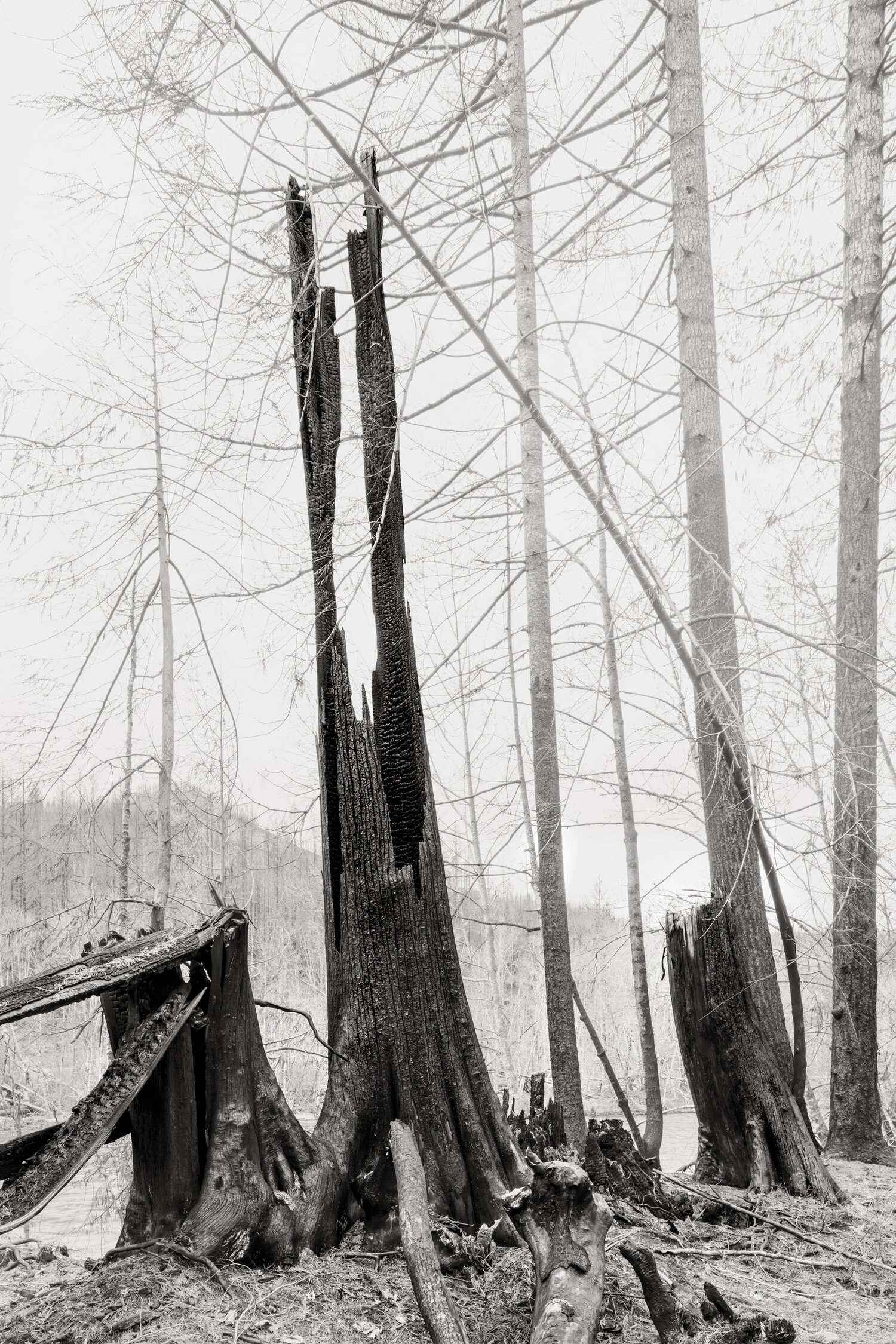
When it does…we can build a new home and studio, but when I imagine the landscape that would surround us post-fire, that is the difficult part.
The fires are quite a reality to come to terms with and to prepare for. It is telling how direct the results of warming have been in your direct surroundings. David, as a logger and photographer, and Fred, as a scientist and nature lover, you must have an intricate understanding of both the life and post-life of the trees that you work with. What has been your photographic mission in relation to the trees themselves?
DPB: To be clear, I was a logger for four years in the mid-1970s. When and where I worked on US Forest Service land in the Sierra Nevada mountains, the timber sales were all selective cutting. When we left a logging site, 60-70% of the forest was still standing. Today’s clear cuts are a very different beast, and I am against industrial tree farming as practiced today.
My photographic path (rather than a mission) has been to explore different facets of the complex relationship between trees/forests and human beings. I have long felt that the way we treat our forests can also be seen in the ways we treat other human beings.
FS: My mission in relation to trees and forests as a scientist has been to learn all I can concerning their history with regard to disturbance events, both natural and human-imposed. I have done this as a participant in a large, long-term ecosystem research team working in the old-growth of the Andrews Experimental Forest in the Oregon Cascades and at Mount St. Helens, which erupted in 1980. The stories from our studies are conveyed to the public through many channels, including works of artists and creative writers who have engaged with these places. I count on the citizenry to take in the sense of awe, wonder, and mystery revealed through these inquiries and be attentive to the natural world's well being.
My photographic path (rather than a mission) has been to explore different facets of the complex relationship between trees/forests and human beings.
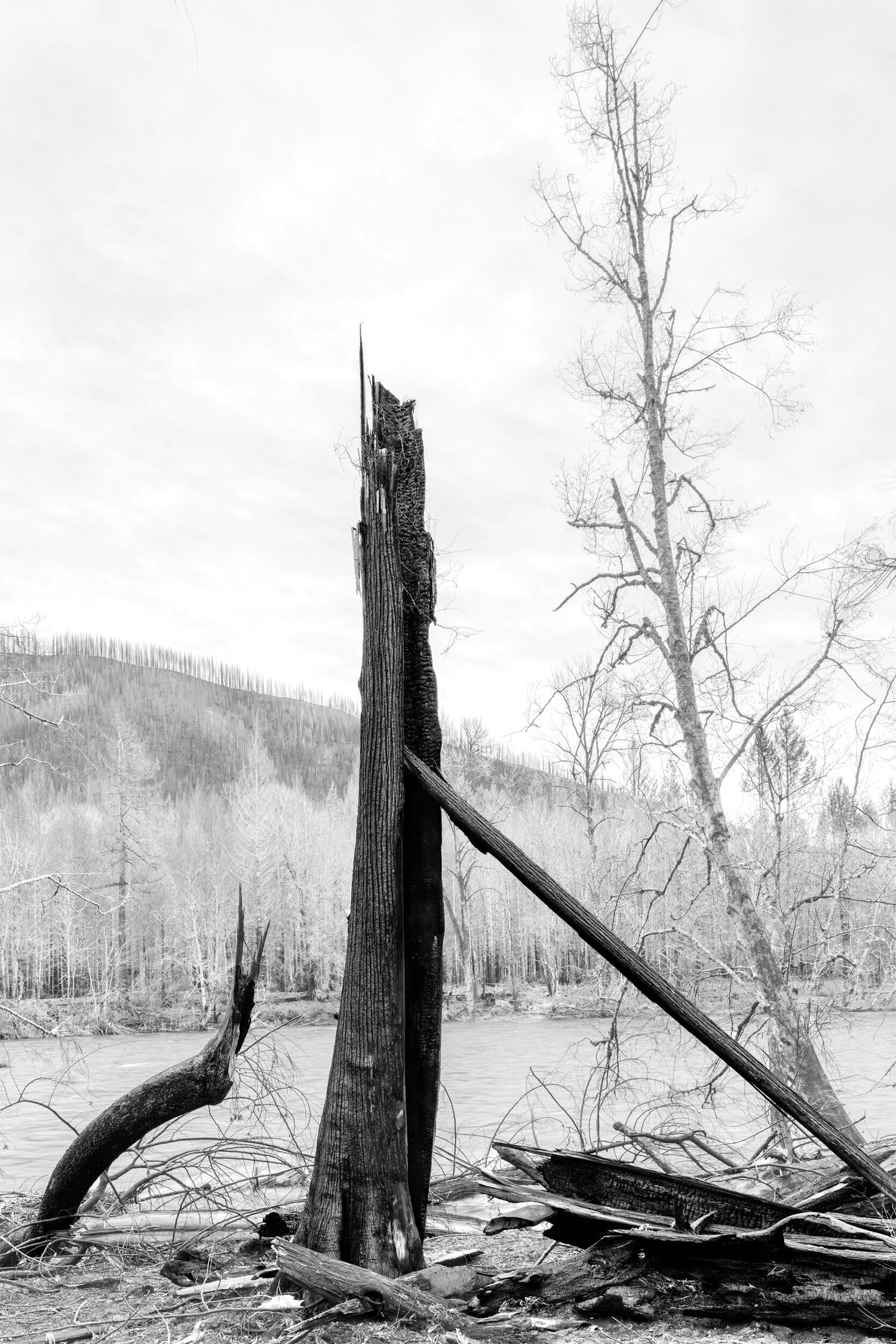
I count on the citizenry to take in the sense of awe, wonder, and mystery revealed through these inquiries and be attentive to the natural world's well being.
Fred, you describe how the citizenry should take in this sense of awe, but you must experience this working with the forest daily. You have studied the effects of climate on regional forests throughout the Western United States. What have been the major changes in the forests that you have studied over the past ten years?
FS: Our home bioregion in the wet conifer forests along the Pacific Coast of the northwest US appears to be in the early stages of profound alteration by climate change. Certainly, other bioregions, such as polar regions, have experienced greater warming and have expressed more significant vulnerabilities as water takes liquid rather than solid forms in soil and on lakes, rivers, seas, and land surfaces. Our long-term research at the Andrews Experimental Forest in the Oregon Cascades shows that air temperature, even under the forest canopy, has been warming over the past 40 years, suggesting that the forest and stream ecosystems are subjected to multiple stresses. Perhaps this warming in the summer months is drying fuels, contributing to the increased intensity of wildfire. With support from the National Science Foundation, the US Forest Service, and other sources, we continue to be vigilant for ecosystem responses.
A common motivation between basic science (Fred calls it ‘Wild Science’) and art is curiosity. We use different languages to explore and express, but motivations are similar.

(David’s) reactions to forms and color prompts have led me to see and ponder the forest in ways new to me.
What incredible findings! The two of you have paired art and science to work as important collaborators in ecology. What can the two disciplines do best together? How have you both been able to build off each other’s work and unique perspectives?
DPB: A common motivation between basic science (Fred calls it ‘Wild Science’) and art is curiosity. We use different languages to explore and express, but motivations are similar. By collaborating and using different languages, we can reach wider audiences. One of the greatest joys in this process has been to share a child-like curiosity with Fred. We both get down on the ground and stick our heads into burned-out stump caverns to look at the first bits of green fire moss or oxalis. A moment later, Fred points to a giant boulder and asks me, ‘Do you know where that came from?’ I’m thinking it’s a boulder. Didn’t it come from underground somewhere? He explains this particular rock was pushed down the canyon by the last glacier 13,000 years ago. Me—awestruck and grateful to share this journey with him.
FS: I have long felt that scientists and their science communications have not been the greatest storytellers. The methods of science can be quite constraining. So, it has been very refreshing to team up with David and visit a situation new to both of us—freshly burned forest. As David puts it, this is a fascinating common ground in which to exercise the common ground of our curiosities. His reactions to forms and color prompts have led me to see and ponder the forest in ways new to me. And, it is inspiring to see how others, both scientists and non-scientists, respond to his works and the forest. Even in its blackened state, there are beauty and mysterious manifestations of complexity and inter-connectedness.
To draw from Robin, we need to be attentive to our “kinship” with trees and have “relationships of reciprocity.”
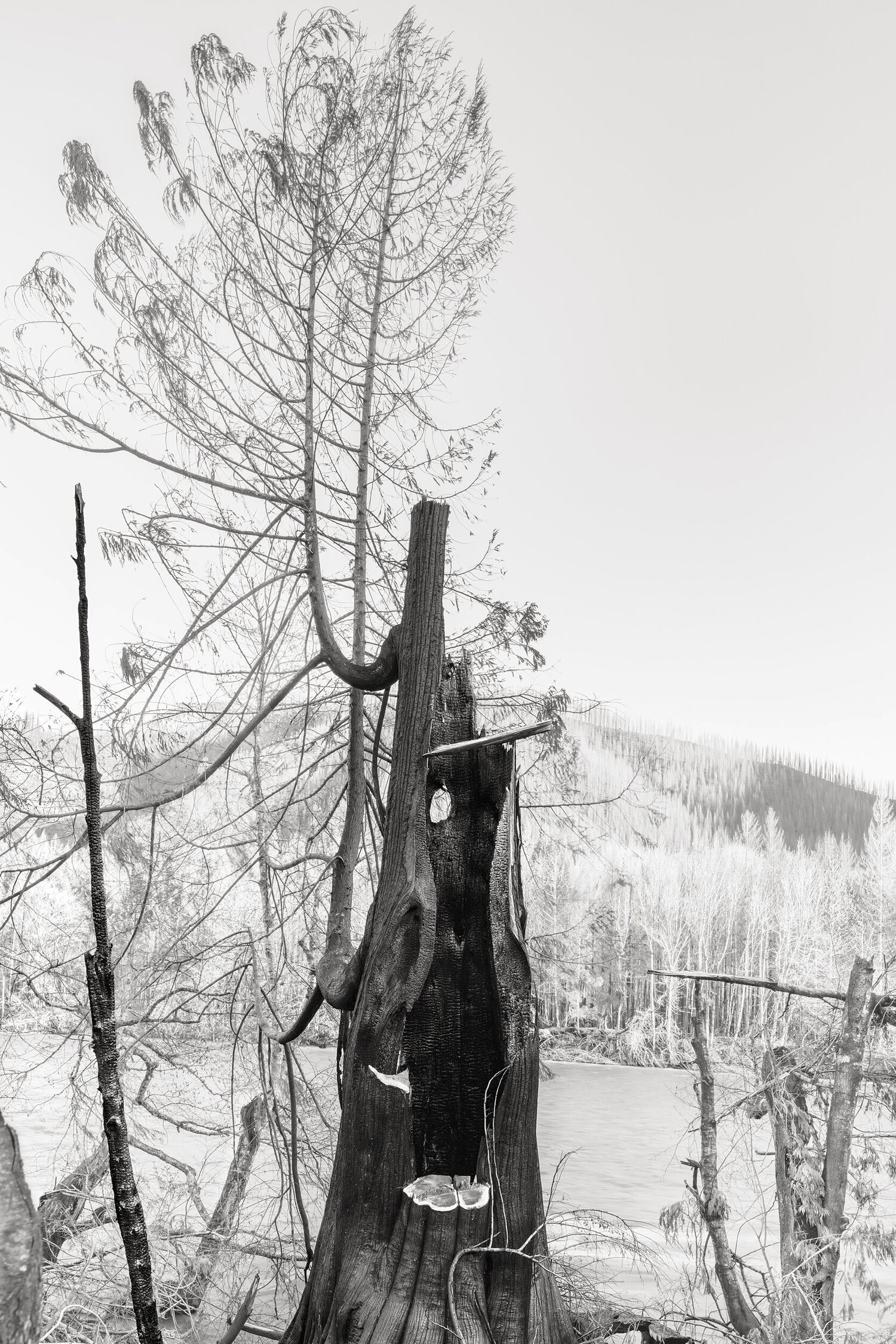
In 1989, I participated with TreePeople in Los Angeles to plant Sequoia seedlings in the Sierras near the Mi-Wuk reservation… Loggers, Mi-Wuk, and urban Angelinos all planting trees together.
Speaking of complexity and interconnectedness: as I write this, the oldest and largest sequoia tree in the world is being wrapped in fire protective blankets. What have been some efforts you have experienced of inter-species collaboration between humans and the trees?
FS: Some human-forest relationships are simple and exploitative, like logging native forests and replacing them with simple plantations. But, in the words of Robin Kimmerer, this is not an “honorable harvest.” Some might argue that, by revealing their histories of disturbance and resilience in tree-ring and other records, forests are teaching us how we may selectively remove trees for our uses while leaving enough of the forest ecosystem that it can continue to function as complex, highly interconnected systems. Again, to draw from Robin, we need to be attentive to our “kinship” with trees and have “relationships of reciprocity.”
DPB: In 1989, I participated with TreePeople in Los Angeles to plant Sequoia seedlings near the Mi-Wuk reservation in the Sierras. Steve Brye, as a volunteer, grew 7,000 seedlings and coordinated this effort with the US Forest Service. A group of urban environmentalists from LA went up to the Sierras to plant all the trees for a weekend. Since it was near where I used to be a logger, I organized some logging families who came out also to help plant the trees. To everyone’s delight and surprise that Saturday morning, Elders and others came from the reservation to bless the planting of the trees and help us plant. Loggers, Mi-Wuk, and urban Angelinos all planting trees together. We finished Sunday afternoon and were spontaneously invited to their Roundhouse to witness a drum and dance ceremony. It was a great weekend.

There are parallels between how we live with each other and how we live with trees.
These are such important messages of reciprocity and collaboration. In your description of “Standing, Still,” you describe, “Treetops broke off, plunging in the river. Limbs dangled, connected by tissues charred and crisp, and still, the cedars stood, a testament to their strength.” The description could also be used for the loss of human life in war. What are the parallels for you between the trees and the human experience?
DPB: Great question—thank you. Fred and I chose specifically to narrow our attention to the forest itself, being quite aware, each time we drove up the highway of all the human loss. So many homes were reduced to concrete foundations with standing chimneys and melted twisted metal roofing. So, these portraits also reflect that. I also felt the collective “Disturbance” the pandemic brought to all of us with loss of life, jobs, incomes, etc. In my book Urban Forest there are images of trees trying to survive along our city streets which can also be seen as unhoused humans trying to survive our city streets. There are parallels between how we live with each other and how we live with trees.
Fire immediately changed the forest dramatically, and now the forest is responding in amazing ways, fast and slow, physical, chemical, and biological.

We can 3D print homes with adobe. We now need to leave trees in the ground, both alive and burned.
I am so glad that you mentioned forest “management” since you both hold unique perspectives related to industrial processes and the forests you work with. David, in your recent work “Hazard Tree,” you discuss the industrial uses of the tree’s “destinies.” How has industry shaped these destinies, and how much of the destruction is necessary? Is there a balance within the forest that is being kept?
DPB: This is a huge topic and difficult to narrow down to an article. It’s not possible to begin without acknowledging that there is, to varying degrees, a mutual dance in our capitalist society of supply and demand. For my first exhibit on this topic, I researched data that showed that from 1950 to 1990, the average family size shrunk from 6 to 4.5, and the average single-family home built increased from 1,200 square feet in 1950 to 2050 square feet in 1990.
Another factor to consider, as we can no longer deny the climate is changing, is where and what is the balance point? For 5,000 years, we have used trees and forests for our purposes of building societies and civilizations. We now need trees and forests in a vastly different way. We can 3D print homes with adobe. We now need to leave trees in the ground, both alive and burned.
3D printing homes is a fantastic way that art and engineering can work together toward climate solutions. What are your hopes surrounding what art can do to create awareness for an ecological response? What can the artistic community do to help the forest recover?
DPB: I hope all our creative endeavors can inspire awe, wonder, and appreciation to create changes in three ways. First, always ask ourselves what we can do personally to bring about the changes we want on a global level. Second, we can’t lose hope in finding ways to apply pressure politically. And third, if you can, donate money to legitimate conservation and land trust entities buying forest and prairie lands, setting them aside to grow and maintain healthy, natural ecosystems.
FS: I have had the pleasure of working with creative writers and artists in the amazing ancient forest of the Andrews Forest and the blast zone of Mount St. Helens since 2000. I see my mission as helping them find their stories in these compelling landscapes, which has taken place through the Long-Term Ecological Reflections program at the interface of the Andrews Forest science program and the Spring Creek Project for Ideas, Nature, and the Written Word in Oregon State University.
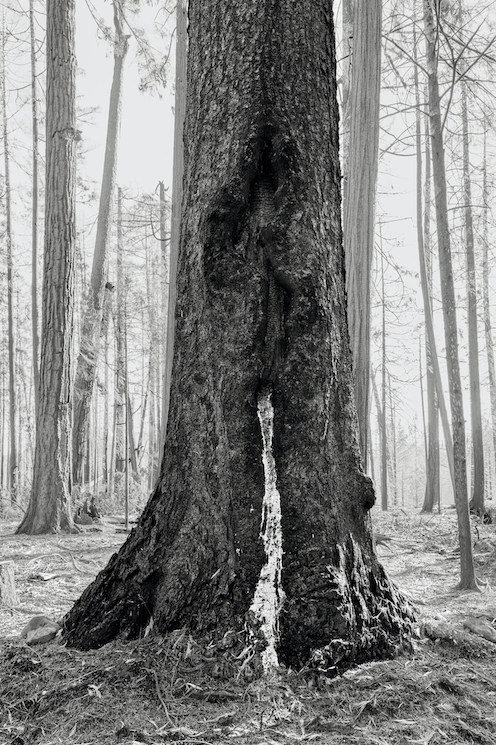
Thank you both for joining me for this excellent discussion. Many of the insights you shared have been eye-opening, offering both warnings and hope in light of the recent disasters.
DPB: Olivia Ann Carye Hallstein, thank you for this opportunity to share our experience in this way. It is very much appreciated. Thanks.
FS: And a hearty thanks from me too.
Images: all photographs by David Paul Bayes are from his Standing, Still series and are numbered 3, 14, 13, 10, 5, 1, 12, 17 as seen from top to bottom.